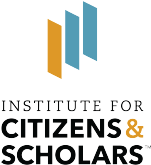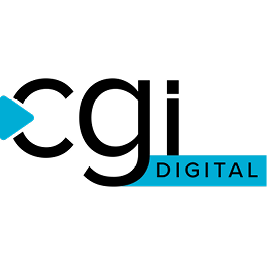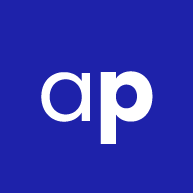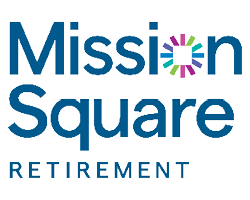By Hala Harik Hayes and Nick Vlahos
A growing number of initiatives from across the ideological spectrum have emerged in recent years to protect, reform, strengthen, and champion American democracy. We call these organizations and networks, and the funders supporting them, the “healthy democracy ecosystem.” For the most part, this ecosystem of healthy democracy networks, practitioners, and funders is quite diffuse. Those working in this area often lack a shared vision of the future, a collective understanding of resource availability and distribution, and a common definition of what efforts fall within the bounds of healthy democracy work.
Both funders and practitioners have recognized a need to see a holistic picture of the work being done to protect and strengthen our democratic institutions and to reestablish the cultural norms necessary for our democracy to thrive. In the spring of 2023, the National Civic League and Center for Democracy Innovation set out to create an interactive website to map the greater ecosystem of organizations, networks, coalitions, and funders promoting healthy American democracy. The project has four main goals:
- To allow new and existing funders to discover and be educated about organizations, networks, and coalitions working in the space, and to highlight the work of organizations;
- To help new organizations entering the arena to learn about existing efforts, and existing organizations, so they can discover potential opportunities for coordination and/or collaboration;
- To enable community practitioners to share best practices, identify local efforts, and learn about current and potential sources of funding; and
- To assist a wide audience to visualize the overall scope of the organizations, networks, and coalitions promoting healthy democracy and how the different fields, subfields, and sectors are supported and connected.
While other landscaping efforts are focused on a specific audience, or specific fields of healthy democracy activity, our map takes a broad approach with multiple, wider audiences (funders, practitioners, the field at large, and Americans interested in learning about healthy democracy.)
We have included all categories of healthy democracy as defined by funders, practitioners, and the organizations themselves using two complementary methodologies undertaken in parallel. One methodology was an expert-driven or top-down method derived from fifty interviews and comments during an April 17, 2023, in-person strategy session. The other was a practitioner-driven, or community-based bottom-up method, collected by reviewing organization’s websites to understand how they describe themselves within their mission statements and programmatic objectives.
Rather than simply creating yet another database, our effort was to provide an attractive, easy to use, searchable, set of visualizations of the democracy ecosystem. This set includes providing different views based on the needs of varying audiences. The result was a free, public resource that is a contribution to the healthy democracy space to benefit funders, practitioners, the field, and the American people.
Methodology
Our project began with an in-person, full-day strategy session in Washington, D.C., with 25 experts in the democracy field from relevant national organizations. Among other things, participants collaborated in an affinity mapping session to develop an initial set of categories that subject matter experts felt captured the types of democracy work in America. Between May and October 2023, we held 50 one-on-one interviews with additional subject matter experts to ascertain their thoughts on the value, usage, and scope of the project.
We asked each of the interviewees to share their ideas about the potential benefits, challenges, and concerns that might accrue from an effort to create an interactive resource featuring visualizations of the topical breadth and financial depth of the healthy democracy space, along with a filterable database of democracy practitioners and funders.
Using feedback from participants we developed a list of categories of healthy democracy work. We reviewed our draft list during these interviews, while also reviewing organization’s websites to understand how organizations describe themselves within their mission statements and programmatic objectives.
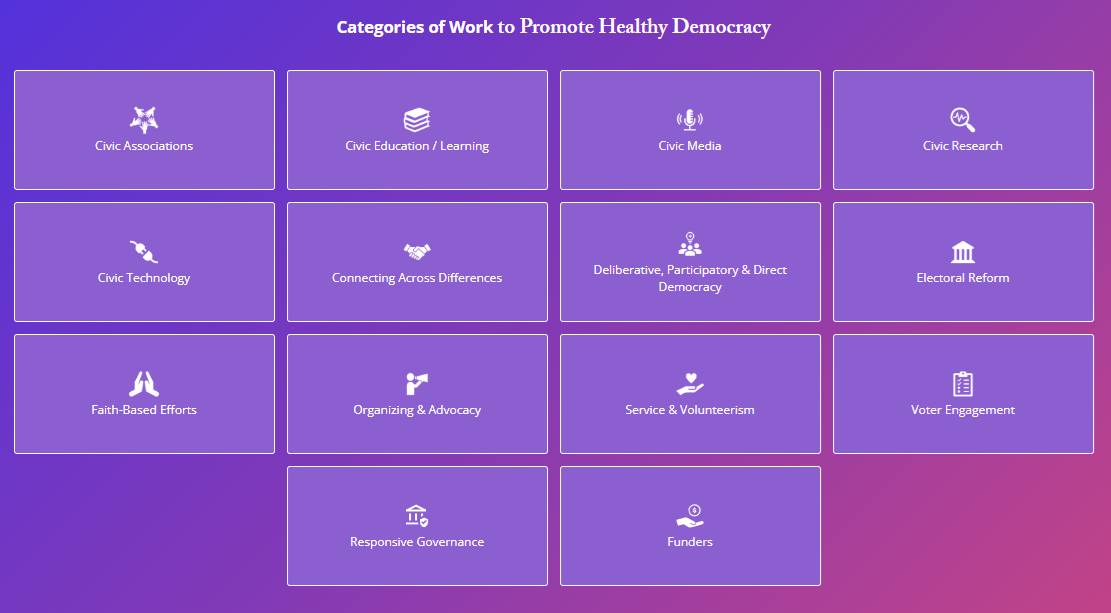
Benefits of the Healthy Democracy Ecosystem
Interviewees were generally enthusiastic about the map and believed it would provide value. We identified seven themes related to the potential value of the mapping project that emerged from this conversation:
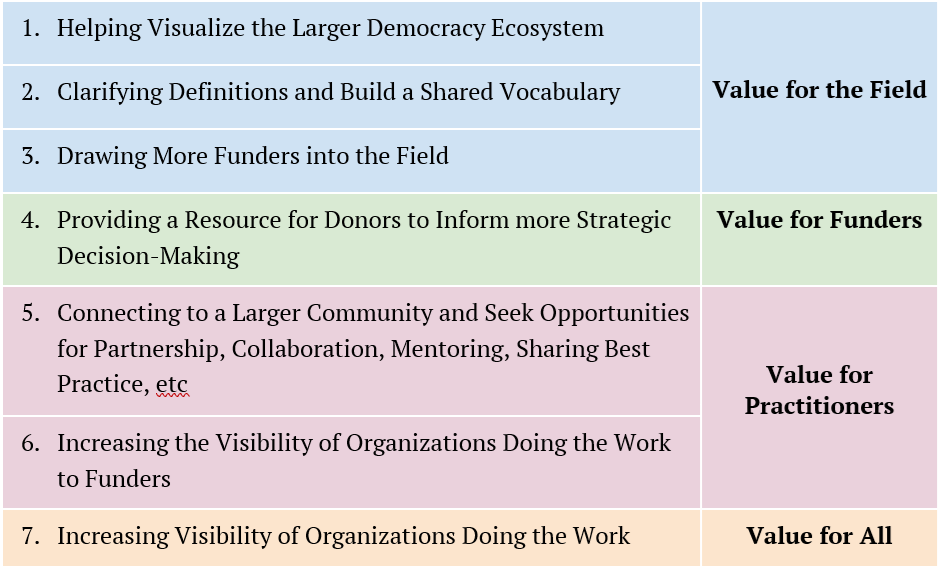
Visualizing the Larger Democracy Ecosystem
Participants pointed to the large and dispersed universe of organizations often working in silos on democracy issues – including many at the local level and “without democracy in their names.” They look forward to using the map to see a big picture perspective of the ecosystem.
“[We are] working with a lot of confusion in a movement that needs to be much more unified…When you do not know the larger impact of your work, we can be lured into perpetuating fragmentation and miss a lot of opportunities for collaboration.”
“[A map] could be valuable to help people understand conceptually the various buckets and spheres of democracy [work] and practically how they connect to it.”
Clarifying Definitions and Building a Shared Vocabulary
Some interviewees spoke of the need to develop a common language for healthy democracy around which everyone can coalesce. Others suggested that providing a centralized location for sharing vocabulary and definitions could help increase collaboration.
“Shed clarity and bring out ways in which people who say they are working on democracy are working on things that are different but compatible.”
“The terms like citizen engagement, public engagement, deliberative democracy, are not well defined or differentiated. Effort to let people know where the areas of expertise are, opportunities to collaborate. Having it all in one place is good.”
Drawing More Funders into the Field
Funders and practitioners alike pointed to the need to increase the number of funders and the amount of funding supporting the healthy democracy ecosystem. They hope to use the map to encourage additional philanthropic support of the field.
“Need a strategy to get in front of donors…work through donor intermediaries.”
“Where are these foundations that have not actively supported civic engagement – how can we push them into this area – ask more of them?”
Providing a Resource for Donors to Inform Better Strategy-making
Both practitioners and funders highlighted the importance of utilizing the map to provide information in real time about resource deployment, potentially improving strategic thinking to inform funding decisions. This could also include increasing the quantity and frequency of collaboration among funders in the healthy democracy space.
“Identify gaps – we may have the perception that more is going on than is real. Also where is the overlap? How can we have the greatest leverage? How do you sequence the work?”
“Updated mapping would also be useful to identify the big funders and practitioners in democracy work. Four years ago you could name the major players off the top of your head, but that’s no longer true…there has been a boom of funding intermediaries who gatekeep. This could be a huge equalizer.”
Connecting to a Larger Community and Seeking Opportunities for Partnership, Collaboration, Mentoring, Sharing Best Practice, etc.
The value most cited by interviewees relates to the ability to better understand who is doing what, and where it is being done. Interviewees believe this knowledge has the ability to transform the field by providing opportunities for organizations to collaborate and learn from each other.
“By its nature this work requires building unusual coalitions working with people on the other side of politics. We don’t know who is out there.”
“It would be so good to know – where are people already covering, where are the gaps? Who is doing what and where can we partner with these orgs? Impact on how money is allocated and how it impacts people’s lives.”
Increasing the Visibility of Organizations Doing the Work to Funders
Interviewees agreed that the map would provide value by highlighting the many organizations currently working in the space whose work is not well known to funders.
“Surfacing organizations that don’t necessarily lead with democracy, that are non-traditional but are developing community and agency and civic engagement.”
“Mapping the diversity of organizations doing this work is critical and doesn’t currently exist… [especially] to the organizations that are more effective at creating social change.”
Increasing the Visibility of Organizations Doing the Work
Interviewees envisioned a map that could help more Americans understand how much work is already taking place to protect and reform democracy, becoming a source of hope and inspiration. This resource could be used as a tool to locate an onramp for participation or as an eye-catching visual highlighting the various organizations already doing the work.
“Inspire everyday Americans, make it easier for people to find us and a point of entry into becoming more civically engaged.”
“The general public will benefit from seeing that at this time when our democratic future can feel hopeless and it seems like our country is in a negative spiral, there is actually a robust ecosystem of democracy support out there. There is hope. It will also be useful if members of the general public can use the site to connect with other people/groups in their community who want to promote democracy.”
Primary Challenges & Concerns
The 50 people interviewed did not shy away from sharing their ideas on the challenges and concerns associated with this process and the final product. Five themes emerged from the interviews:
- Avoiding Duplicating Other Mapping Efforts
- Ensuring an Inclusive Process that Embraces All Political Perspectives and Avoids Partisan Language
- Balancing Transparency and Safety
- Creating an Inclusive Resource with Continually Updated, Verified Information
- Respecting the Appropriate Roles of Both National and Local Efforts
The quotes beneath the themes are the actual words of interviewees. Our team had many of the same concerns and following the quotes we’ve shared with you the actions taken to guard against these concerns.
A few interviewees asked why we would even undertake this project. Others noted that there are maps or landscape analyses already underway. This theme emerged during our April 17, 2023 Strategy Session as well as early in the interview process.
“I am puzzled by this project because it seems that every two to three years someone comes up with a new landscape analysis mapping project. Maybe this is because the field is growing so rapidly, and the landscape is changing.”
“Lots of landscaping going on. The democracy space is enormous – even if you go into one subfield, the amount of mapping and theory you might be doing is huge – the broader you go, the more what you’re producing has to be at a high level.”
Actions Taken:
We appended our interview to include a question where we specifically asked participants to share similar mapping or landscape review projects of which they were aware. Our project team compiled this information in the list below.
Other Mapping / Landscaping Projects
- Member Network Map (National Coalition for Dialogue & Deliberation)
- Bridging Map (Princeton Bridging Divides Initiative)
- Building Resilience Ecosystem Map (Princeton Bridging Divides Initiative)
- Foundation Funding for U.S. Democracy (Candid)
- Data Archive (National Center for Charitable Statistics)
- Citizen Connect (Bridge Alliance)
- Bridge Builders Map (Los Angeles Bridge Builders Collective)
- Pro Democracy Ecosystem (Horizons Project)
- Georgia Pillars of Authoritarianism (Horizons Project)
- Metamodernist Ecosystem (Life Itself)
- Democracy Coalitions Map (Inter-Movement Impact Project)
- LittleSis (Public Accountability Initiative)
- Roadmap for Local News (City Bureau)
- Voter Engagement Case Studies (Nonprofit VOTE)
- More Perfect (More Perfect)
- TurnUp (TurnUp Activism)
- Mapping the Modern Agora (JHU SNF Agora Institute)
We’re collaborating and sharing data with the bolded initiatives and have also connected with informal or non-public lists.
Ensuring an Inclusive Process that Embraces All Political Perspectives and Avoids Partisan Language
Many participants, especially those more aligned with the center/right of the political spectrum, noted the importance of providing an objective and nonpartisan approach to healthy democracy. Some asked whether the explosion of organizations doing democracy work is a response to partisan fears and polarization.
“We have to have a common nomenclature, a common civic language that we all speak in order to keep the country together…For everyone of these categories, you want to ask, does the language stitch us together?”
“Nitpick the language. Drive this down the middle, [you] need to be nonpartisan.”
Actions Taken:
To this end, the team developed criteria for inclusion in the ecosystem map. We include organizations that engage the public in meaningful ways across various types of democratic work. These groups cannot be partisan, promote hate speech, and they need to minimally have a visible digital presence (like a website or Facebook page) for the public to find them and be able to contact them. We have also invested significant time and effort into trying to make our project language as ideologically inclusive as possible. Additionally, the categories of healthy democracy draw heavily from the way organizations describe themselves within their mission statements and programmatic objectives.
Balancing Transparency and Safety
We asked interviewees to share any downsides to making healthy democracy information on organizations available on the map. A strong theme emerged around providing a method of sharing information transparently while simultaneously safeguarding personal information and providing enough background for users to understand as much as possible about the organizations mapped.
“A map provides evidence for disinformation campaigns; certain interest groups will take this list and use it to develop a battle plan for who they will go after.”
“Providing transparency without meaningful context and a clear narrative actually fuels disinformation, rather than curtailing it.”
Actions Taken:
We agree with the need to promote transparency as well as the reality that readily available information can be used for dark purposes. Our project team has opted to make the ecosystem map public so anyone can manually review organizations. However, users are not able to download the larger list of organizations or use AI to scrape organizational data from the map.
Creating an Inclusive Resource with Continually Updated, Verified Information
Participants raised the importance of keeping the map up to date and evergreen from the start. Suggestions included providing a method for organizations to add themselves or update their information on the map in real time while ensuring a person verifies and confirms the accuracy of the information, and pairing data-scraping or AI with human oversight to regularly review and update the map. Participants also stressed the need to curate the content with an emphasis on reviewing the impact and efficiency of organizations on the map.
“Danger is in excluding organizations or in the data becoming out of date. Need continued data scraping to keep up to date.”
“In a resource starved environment, we don’t have time for conversations that feel good but don’t lead to systemic change…. If [the work] doesn’t lead to real change that is measurable, then we are not solving the biggest issues that are plaguing our country.”
Actions Taken:
In addition to manual tagging, we are experimenting with generative AI to help fill out our data set with any missing organizational information (e.g. website, location, mission statement, etc.) and help assign top-down and bottom-up categories. Our use of AI, while in the early stages, is highly iterative, and we are continuing to tag and sort data manually as a way of checking the AI output and ‘training’ the technology so that it becomes more accurate and precise. Our goal is to offer both ongoing data scraping and a streamlined process for individuals and organizations to add themselves to the map to keep the data fresh and accurate.
Respecting the Appropriate Roles of Both National and Local Efforts
Local funders and practitioners pointed to the need to elevate community and place-based work in a way that provides support and assistance. They shared stories of funders and national level organizations taking a one size fits all approach and cautioned us to consider local ecosystems as well as national ones.
“National studies don’t always understand the nuance of how fragile democracy is on the ground in local places. Talk to people locally.”
“I’m concerned about national organizations stomping on local initiatives; present the map in a way that is place-dependent, and hold with tenderness the idea of local ecosystems.”
Actions Taken:
Our project team has made a pointed effort to seek input from practitioners, funders, and organizations beyond the largest, most well-known players in the field. While our April 17, 2023 Strategy Session did feature participation from 25 experts in relevant national organizations, the individuals contacted for interviews were deliberately selected to provide greater geographic representation and drawn from all levels of engagement: community/local, state, regional, and national.
Conclusion
The Healthy Democracy Ecosystem Map has provided a clearer picture of the thousands of organizations, practitioners, and funders that exist in the democracy space. It also has the potential to inspire greater coordination, strategic investment, and public engagement, offering hope for a more resilient and vibrant democracy in the years to come.
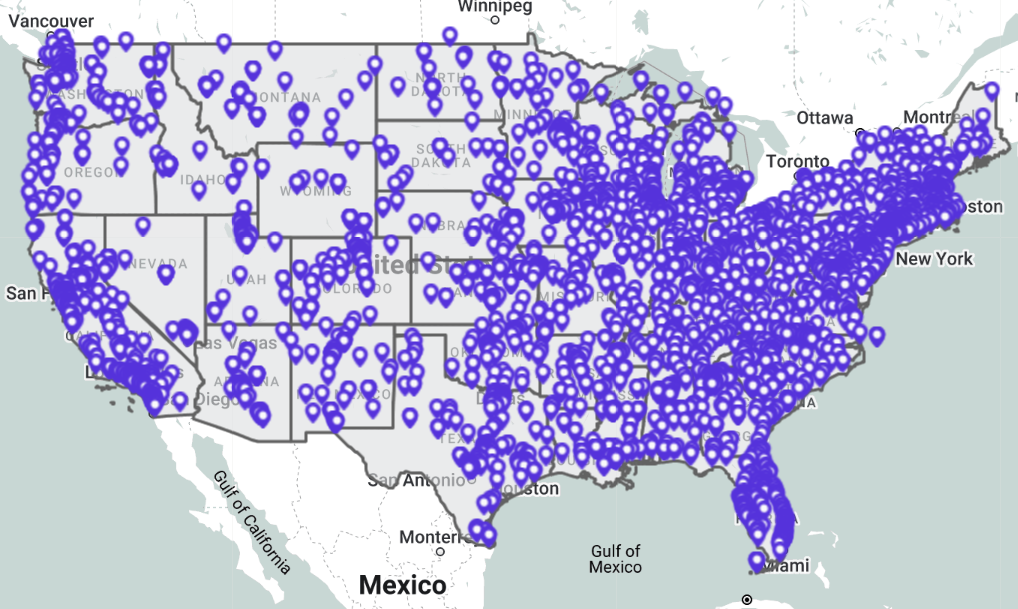
By providing an accessible, visually engaging, and continually updated resource, this project seeks to break down silos, amplify visibility, and empower both new and established efforts.
While this map marks an important milestone, it is far from complete. This public resource will hopefully continue to grow with the input of practitioners, funders, and communities. We encourage people to reach out, and for interested organizations to join our map by filling out our submission form.
The map provides mores than a snapshot of what exists — it’s a call to action. In understanding the landscape of efforts, we gain insight into both the challenges and the extraordinary opportunities to ensure democracy thrives. Moving forward, the success of this initiative will depend on sustained collaboration, thoughtful curation, and iterative improvements driven by input from the field. The map is not merely a static tool, but a living reflection of a growing movement to champion healthy democratic institutions and civic culture.
For further information, visit the Healthy Democracy Ecosystem Map website at www.healthydemocracymap.org to explore the map, criteria for the inclusion of organizations, and the list of democracy categories and organizational goals.
Hala Harik Hayes is a principle at Public Engagement Associates. With over twenty years of experience specializing in civic and community engagement strategy, she is an expert in project management, public meeting design, and facilitation.
Nick Vlahos is Deputy Director of the Center for Democracy Innovation at the National Civic League.

